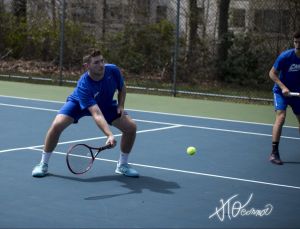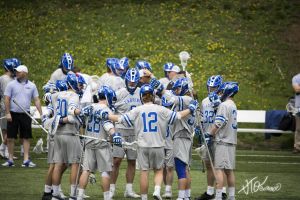On March 12, in response to the growing COVID-19 pandemic in the U.S., the NCAA announced that it was canceling its remaining winter and spring championships for the 2019-2020 academic year. Because of the effect that had on the athletes taking part in those sports, specifically those taking place in the spring semester, the NCAA voted on March 30 to grant those spring athletes an extra year of athletics eligibility.
This enables not just the seniors likely graduating in 2020, but all spring sport athletes across the NCAA’s three divisions, to make up for that extra year and play their full eligibility at the college level. However, while at Divisions I and II athletic scholarships are available and the guidelines around them were relaxed to make room for the added demand, at the Division III level athletic scholarships are not allowed. This means that if a senior spring athlete at Cabrini wants to play their last year of college before moving on to their career, they have to pay for it out of pocket.
“I think it’s probably great for kids that maybe are not graduating on time, or are a Division I athlete and there’s a scholarship involved,” Cabrini’s women’s lacrosse and field hockey head coach Jackie Neary said. “I don’t see any impact on my lacrosse team, where I have four seniors that are all graduating.”
That is going to be a very common theme as this develops. Many seniors have jobs lined up well before they graduate from college and even if that is not the case, another year’s tuition could be financially crippling. College scholarships, whether from the school itself or a third party, often only last for eight semesters before the student is on their own. Even with financial aid or student loans, that is another year of paying for school that will only add on to a student’s debt.
“It’s different for everybody, but there’s a cost involved, especially at D-III, but it is great for a young man/lady who is either an underclassman or not graduating on time,” Neary said.
So how many athletes are there who can take advantage of this?
Well, for starters, if a student-athlete was already planning on going to graduate school immediately after receiving their bachelor’s degree, then they can easily come back for another year, but that’s not a big group. The other option is to try and pay for it themselves, which presents multiple problems.

“Most likely I am not going to use that eligibility,” C.J. Lamantia, a senior business management major on the tennis team at Cabrini, said. “I don’t have any more credits to take and I would have to pay for an extra year, which I don’t plan on doing.”
The financial aspect of this is very real. The average tuition across 400-plus Division III colleges and universities is around $27,200 per year, and there is a large standard deviation in that sample, meaning that there are a lot of schools that are nowhere near that figure. For every Penn State-Brandywine, where the tuition is about $14,000 a year for in-state students, there is a Cabrini, where the overall student cost is upwards of $45,000 a year regardless of home state.
For every CUNY (City University of New York) Brooklyn College, where in-state students pay around $7,000 per year, there is a Swarthmore, where total student costs can top $70,000 annually.
For other people, having jobs lined up right out of school will keep them from being able to take advantage of their extra athletic eligibility. According to MyStudentVoices.com, as of 2017, only 33 percent of college students have secured full-time jobs beyond graduation. However, of that 33 percent, 78 percent have a job in their desired field and 61 percent have a well-paying job right out of school, earning roughly $60,000 annually upon entering the workforce.
“I already have a job lined up as well, so it’s tough to see it end like this but it is what it is,” Lamantia said.

Then there is the matter of recruiting. College coaches plan out the size of their recruiting classes each year based on the number of players they will be losing, specifically the size of the senior class. The problem is that when four classes worth of athletes suddenly have an extra year to play, those who utilize that will create a logjam of players trying to get on the field/court/whatever playing surface applies. This is a matter of importance for Cabrini softball’s senior second baseman, Ally Schell, while deciding what she wants to do.
“Personally, I don’t think I’ll use my extra year of eligibility, just because I think it takes away from someone’s actual senior year,” Schell, a business management major, said. “I feel like not everyone’s going to make an attempt, at least like the underclassmen, to use that fifth year of college.”
For a lot of athletes, these obstacles and moral hangups are enough for them to make their peace with calling it a career and moving on with their lives. However, for others, the will to keep playing is enough for them to do everything in their power to make sure they finish on their terms.

“My first thought [about the extra year] was that I want nothing more than to come back, but is it really possible with school and everything?” Tommy DeLuca, a senior business management major and defender for the men’s lacrosse team, said. “I think I’m going to use it, I’m not entirely sure yet but I definitely want to; my parents and I are trying to figure out the details of it.”
It remains to be seen whether the group who, like DeLuca, will do anything and everything they can to keep playing and finish their career on their terms will outnumber those who, whatever their reason may be, are content with this being the end of their playing days. While only time will tell, it is important to acknowledge the accomplishments of those seniors nonetheless.
Lamantia was a three-time all-conference recipient and two-time conference player of the year, once in the Colonial States Athletic Conference (CSAC) and once in the Atlantic East Conference (AEC).
Schell was twice named to the CSAC All-Academic team, a 2019 All-AEC recipient and leaves Cabrini with the fifth-most triples in program history.
DeLuca was a three-time All-Conference honoree, a 2019 All-American (USILA second team, IMLCA first team), 2019 IMLCA Defensive Player of the Year, a vital piece of the 2019 National Championship team and leaves Cabrini as the program’s all-time leader in caused turnovers per game.
“I enjoyed my three years at Cabrini,” Lamantia said. “I made incredible friends, had great teammates and staff, they’ve done a great job, but sadly my career is coming to an end.”


